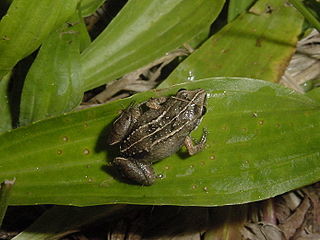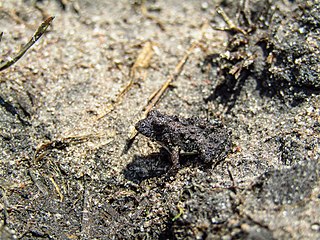
Heterixalus alboguttatus is a species of frogs in the family Hyperoliidae endemic to Madagascar. Its natural habitats are subtropical or tropical moist lowland forests, subtropical or tropical moist shrubland, subtropical or tropical seasonally wet or flooded lowland grassland, swamps, freshwater marshes, intermittent freshwater marshes, arable land, heavily degraded former forests, ponds, irrigated land, and seasonally flooded agricultural land. In the pet trade, it is commonly called the starry night reed frog, because of its patterning.

Heterixalus betsileo is a species of frogs in the family Hyperoliidae endemic to Madagascar. Its natural habitats are subtropical or tropical moist lowland forests, subtropical or tropical moist montane forests, moist savanna, subtropical or tropical seasonally wet or flooded lowland grassland, subtropical or tropical high-altitude grassland, swamps, freshwater marshes, intermittent freshwater marshes, arable land, rural gardens, urban areas, heavily degraded former forests, ponds, irrigated land, seasonally flooded agricultural land, and canals and ditches.

Heterixalus madagascariensis is a species of frog in the family Hyperoliidae endemic to Madagascar. Its natural habitats are subtropical or tropical dry forests, subtropical or tropical moist lowland forests, moist savanna, subtropical or tropical seasonally wet or flooded lowland grassland, swamps, freshwater marshes, intermittent freshwater marshes, sandy shores, arable land, urban areas, heavily degraded former forests, ponds, irrigated land, and seasonally flooded agricultural land.
Hyperolius pyrrhodictyon is a species of frog in the family Hyperoliidae. It is endemic to Zambia. Its natural habitats are dry savanna, moist savanna, subtropical or tropical dry shrubland, subtropical or tropical moist shrubland, subtropical or tropical dry lowland grassland, subtropical or tropical seasonally wet or flooded lowland grassland, rivers, swamps, freshwater lakes, intermittent freshwater lakes, freshwater marshes, intermittent freshwater marshes, arable land, pastureland, urban areas, heavily degraded former forest, water storage areas, ponds, open excavations, irrigated land, seasonally flooded agricultural land, and canals and ditches.

The common reed frog is a species of tree frogs in the family Hyperoliidae found in Burundi, the Democratic Republic of the Congo, Ethiopia, Kenya, Rwanda, Sudan, Tanzania, and Uganda, and possibly the Central African Republic, Chad, and Eritrea. Its natural habitats are subtropical or tropical dry forest, subtropical or tropical moist lowland forest, subtropical or tropical moist montane forest, dry savanna, moist savanna, subtropical or tropical dry shrubland, subtropical or tropical moist shrubland, subtropical or tropical seasonally wet or flooded lowland grassland, subtropical or tropical high-altitude grassland, rivers, swamps, freshwater lakes, intermittent freshwater lakes, freshwater marshes, intermittent freshwater marshes, freshwater springs, arable land, pastureland, rural gardens, urban areas, heavily degraded former forests, water storage areas, ponds, irrigated land, seasonally flooded agricultural land, and canals and ditches.

The grass coqui or coqui de las hierbas is a species of frog in the family Eleutherodactylidae, endemic to Puerto Rico. Its natural habitats are subtropical or tropical moist lowland forest, subtropical or tropical moist montane forest, subtropical or tropical seasonally wet or flooded lowland grassland, plantations, rural gardens, and heavily degraded former forest. It is threatened by habitat loss.

Eleutherodactylus cuneatus is a species of frog in the family Eleutherodactylidae endemic to Cuba. Its natural habitats are subtropical or tropical moist lowland forest, subtropical or tropical moist montane forest, subtropical or tropical moist shrubland, subtropical or tropical seasonally wet or flooded lowland grassland, rivers, arable land, pastureland, plantations, rural gardens, urban areas, heavily degraded former forest, and seasonally flooded agricultural land.

Eleutherodactylus martinicensis is a species of frog in the family Eleutherodactylidae found in Antigua and Barbuda, Dominica, Guadeloupe, Martinique, and Saint Lucia. Its natural habitats are subtropical or tropical dry forests, subtropical or tropical moist lowland forests, subtropical or tropical moist montane forests, subtropical or tropical moist shrubland, subtropical or tropical seasonally wet or flooded lowland grassland, arable land, pastureland, plantations, rural gardens, urban areas, and heavily degraded former forests. It is threatened by habitat loss.

Eleutherodactylus varleyi is a species of frog in the family Eleutherodactylidae endemic to Cuba. Its natural habitats are subtropical or tropical moist lowland forest, subtropical or tropical seasonally wet or flooded lowland grassland, arable land, pastureland, plantations, rural gardens, urban areas, and heavily degraded former forest.

Leptodactylus fuscus is a species of frog in the family Leptodactylidae. Its local names are rana picuda and rana silbador.

Physalaemus cuvieri is a species of frog in the family Leptodactylidae. It is found in Argentina, Brazil, Paraguay, and possibly also Bolivia, Guyana, Uruguay, and Venezuela. Its natural habitats are subtropical or tropical moist lowland forests, moist savanna, subtropical or tropical dry lowland grassland, subtropical or tropical seasonally wet or flooded lowland grassland, intermittent freshwater lakes, intermittent freshwater marshes, arable land, pastureland, plantations, rural gardens, urban areas, heavily degraded former forest, ponds, irrigated land, seasonally flooded agricultural land, and canals and ditches. It is threatened by habitat loss.

Pseudopaludicola boliviana is a species of frog in the family Leptodactylidae. It is found in Argentina, Bolivia, Brazil, Colombia, Guyana, Paraguay, Suriname, and Venezuela. Its natural habitats are subtropical or tropical dry forests, subtropical or tropical moist lowland forests, moist savanna, subtropical or tropical seasonally wet or flooded lowland grassland, swamps, freshwater marshes, intermittent freshwater marshes, pastureland, ponds, irrigated land, and seasonally flooded agricultural land.
Limnonectes acanthi is a species of frog in the family Dicroglossidae. It is endemic to the Philippines. Its natural habitats are subtropical or tropical dry forests, subtropical or tropical moist lowland forests, subtropical or tropical moist montane forests, rivers, intermittent rivers, freshwater marshes, intermittent freshwater marshes, irrigated land, and seasonally flooded agricultural land. It is a common species, but it is threatened by habitat loss. It is also caught for food.

The Angola river frog, or common river frog, is a species of frog in the family Pyxicephalidae. Formerly, it was placed in the family Ranidae.

The crowned bullfrog is a species of frog in the family Dicroglossidae. It is found in the Sub-Saharan Africa . Its natural habitats are subtropical or tropical moist lowland forest, dry savanna, moist savanna, subtropical or tropical dry shrubland, subtropical or tropical moist shrubland, subtropical or tropical dry lowland grassland, subtropical or tropical seasonally wet or flooded lowland grassland, rivers, intermittent rivers, freshwater lakes, intermittent freshwater lakes, freshwater marshes, intermittent freshwater marshes, freshwater springs, arable land, pastureland, rural gardens, heavily degraded former forest, and ponds.

The small disked frog or swamp frog is a species of frog in the family Dicroglossidae. It is endemic to the Philippines.
The Giant Visayan frog is a species of frog in the family Dicroglossidae. It is endemic to the Philippines, and is known from Masbate, Cebu, Negros, Guimaras, Panay, and Siquijor islands.

The Woodworth's frog is a species of frog in the family Dicroglossidae. It is endemic to the Philippines. Its natural habitats are subtropical or tropical moist lowland forest, subtropical or tropical moist montane forest, subtropical or tropical moist shrubland, subtropical or tropical seasonally wet or flooded lowland grassland, rivers, intermittent rivers, freshwater lakes, intermittent freshwater lakes, freshwater marshes, intermittent freshwater marshes, freshwater springs, coastal freshwater lagoons, arable land, pastureland, plantations, rural gardens, urban areas, water storage areas, ponds, aquaculture ponds, open excavations, irrigated land, and seasonally flooded agricultural land.

The Mascarene grass frog, or Mascarene ridged frog, is a species of frog in the family Ptychadenidae. It is found in sub-Saharan Africa, Madagascar, and Mauritius.

The marbled snout-burrower is a species of frog in the family Hemisotidae. It is found in sub-Saharan Africa. Its natural habitats are subtropical or tropical dry forest, subtropical or tropical moist lowland forest, dry savanna, moist savanna, subtropical or tropical moist shrubland, subtropical or tropical high-altitude grassland, swamps, freshwater lakes, intermittent freshwater lakes, freshwater marshes, intermittent freshwater marshes, arable land, plantations, seasonally flooded agricultural land, and canals and ditches. It is also called the mottled shovelnose frog and marbled shovelnose frog.

















